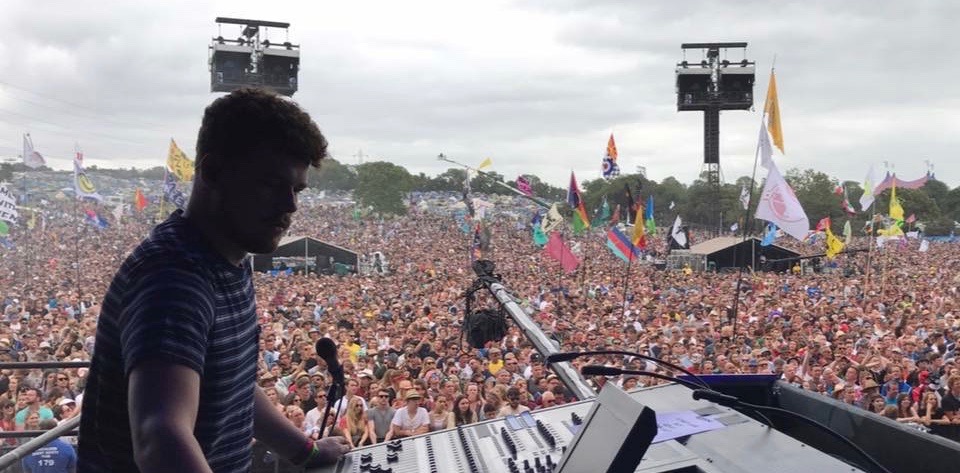In 2013, punters paid just £3 to watch Blossoms’ first live show at Night & Day Café in Manchester. What a bargain! Since then, the Stockport five-piece’s rise to the top has been exponential. Their self-titled debut record hit the top spot in the UK Albums Chart, earning them a Mercury Music Prize nomination along the way, and for the last 18 months, they’ve been touring non-stop around the world. With album two on the way, we talk to Blossoms’ lead guitarist, Josh Dewhurst, and the band’s live engineers, about touring life, top kit, and constantly striving for more.
These past few years have been a whirlwind,” admits Josh Dewhurst. “We’d generated this kind of buzz, as we have always been hands-on with everything; then the album came out, hit number one, we’ve been touring it relentlessly. It’s been pretty crazy!”
A good crazy, though, no doubt. The lads have come a long way since the beginning of 2014, when their fanbase was just 200 local fans. Now, it’s on a global scale. But Blossoms won't forget their roots. What’s the key been to this success?
“Honestly, we are just five very normal, happy human beings from Stockport,” smiles Dewhurst. “Each one of us is creatively involved: [bassist] Chas is great with photography and design, as well as music; [frontman] Tom writes the songs, brings them to us, and they become Blossoms when we put our own influences in.
“Each one of us is a vital cog in the machine, really. We’re still young, but the things you learn yourself when you’re on the road, like people trying to take advantage of you creatively, we have always managed to stay clear of; we’ve always been in charge of the creative process. We have great management and crew, and we have always stayed true.”
A wise attitude on young shoulders, five times over, then?
“A lot of people are liable to take the foot off the gas when they get a bit of success, but there has never been one end goal for us; we know it’s more fuel to keep us going, and to go further. We are never satisfied, and there are always so many more things we can be doing to improve ourselves.”
Dewhurst was the band member that pushed from an early stage to take the audio technology a step further on the road.
“I’m nerdy, so that’s what I’m into,” he laughs. “But yeah, I pushed for tracks, and in-ears; I was the one who was keen to try different mics out, that kind of thing, you know?
“In the studio, we work with Rich Turvey and James Skelly [of The Coral], and it’s like hand-me-down clothes, as we use a lot of their gear in the studio. Music is one of the best things to unite people, especially music of the north and north-west; the history is amazing, really.”
True enough. And The Coral story is an interesting one: Blossoms recorded their first single as a band in 2013 – Blow - in their old rehearsal room with just one mic. It was, Dewhurst insists, ‘dead basic and gnarly’, but it was enough to prick James Skelly's ears.
“James stumbled across it on YouTube, got in touch with us through his manager - who is now our manager - and invited us to Hoylake, where they have their rehearsal room; that’s where we started our relationship with James,” Dewhurst explains. “He is what we call a Jedi Master – so, a mentor – and The Coral were a hugely successful and amazing band, so to have someone like him on board withus is a massive part of our story so far, without a doubt.”
So the formula works in the studio and on the road. Where do you go from here, sonically?
“Well, we are far from perfect, but relentless touring is a great way to improve your playing and tightness,” states Dewhurst. “To live with five lads and crew together is gruelling and amazing at the same time. So I think we have evolved sonically, and the second album is sounding bigger than ever – we feel we’re on a whole new level now, really.
“And when we tour the new album, that’s a whole new journey in itself; and you never know where it’ll take you. We are in such a privileged position as people and musicians, so we need to make the most of that.”
Not all bands speak highly of their labels, but the guys at Virgin EMI seem to have allowed Blossoms to be themselves musically, which is great to hear. In control, in other words.
“No-one wanted to sign us back in the day! But [SJM Concerts] Conrad Murray and Dave Salmon co-manage us, and they’ve always been our guidance, and very supportive. I remember when Conrad sent the label Charlemagne, which we had just recorded, and that song fast-tracked us the album deal. Down to London, sign the papers, and that was it.”
So album two is Blossoms on musical steroids of sorts?
“[laughs] It’s definitely us taking on all we’ve learned, and we’ve produced the best album we can, and we are all proud of it, and can’t wait for everyone to hear it. It’ll be out this year, and hopefully the sun will be shining, so... [smiles]”

